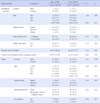Abstract
Purpose
The aim of this study was to evaluate the process and outcome of a mobile computerized system for individual home visiting healthcare.
Methods
A nonequivalent control group non-synchronized design was employed for this study. The newly constructed system was administered to 80 healthcare providers in the experimental group for 8 weeks. Data were analyzed using descriptive analysis, t-test, and ANCOVA with the SPSS 18.0 program.
Results
In the process stage, the difference in the frequency of computerized information usage between the experimental and control groups was significant as 8.88±3.20 and 7.08±2.92, respectively (t=3.90, p<.001). In the outcome evaluation stage, all kinds of healthy lifestyle such as alcohol use, nutrition, weight management and mental health were not improved.
Figures and Tables
References
1. Bae JJ, Choi SO. The development of exercise prescription infrastructure and web application for u-healthcare. J Sport Leis Stud. 2009. 37:1217–1230.
2. Busan Metropolitan City u-City Politics Team. Strategy for vitalization for u-healthcare. Paper presented at the meeting of the u-healthcare manager, Busan. 2008. 03.
3. Garner DM, Olmsted MP, Bohr Y, Garfinkel PE. The eating attitudes test: Psychometric features and clinical correlates. Psychol Med. 1982. 12:871–878.

4. Guillemin F, Paul-Dauphin A, Virion JM, Bouchet C, Briancon S. The DUKE health profile: A generic instrument to measure the quality of life tied to health. Sante Publique. 1997. 9:35–44.
5. Jung WS, Oh YH. Patient monitering system base on U-health. J Korean Inst Commun Sci. 2008. 33:575–582.
6. Kim CJ, Lee WH, Lee CY, Kweon BE, Kim CS, Moon SM, et al. An analysis of the work of visiting health care providers in public health centers. J Korea Community Health Nurs Acad Soc. 2004. 18:178–186.
7. Kim J, Lee S, Park S, Piao M, Joo J, Kim S. Comparison of physicians' and patients' perception on the effect of internet health information. J Korean Soc Med Inform. 2009. 15:373–379.

8. Kim MS, Lee HJ, Kim YH, Kim JS. Nursing cost in operating room applying the resource-based relative value scale (RBRVS). J Korean Acad Nurs Adm. 2002. 8:283–293.
9. Kim MS. Validity and reliability of informatics competencies for nurses among Korean nurses. J Korean Acad Adult Nurs. 2008. 20:470–480.
10. Management Center for Health Promotion. A cost benefit analysis of individual home visiting health care. 2009. Seoul: Author.
11. Ministry of Health and Welfare. Introduction of customized home visiting heath care project in 2009. 2008. Seoul: Author.
12. Nguyen TD, Attkisson CC, Stegner BL. Assessment of patient satisfaction: Development and refinement of a service evaluation questionnaire. Eval Program Plann. 1983. 6:299–314.

13. Oh S, Kim WS. The implementation of bio-signal measuring system based on mobile terminal. Mag IEEK. 2008. 45:1–10.
14. Park HM. An empirical study on student satisfaction of u-learning service-focused on UMPC. 2008. Busan: Pukyong National University;Unpublished master's thesis.
15. Park MJ, Jung MH. The observation on health indexes of visiting health management before and after access to u-health care. J Korean Soc Living Environ Syst. 2008. 15:42–50.
16. Roberts L. Health information and the Internet: The 5 Cs website evaluation tool. Br J Nurs. 2010. 19:322–325.

17. Ryu HS, Park ES, Park YJ, Han KS, Lim JY. A workload analysis of a visiting nursing service based on a health center in Seoul. J Korean Acad Nurs. 2003. 33:1018–1027.

18. Saunders JB, Aasland OG, Amundsen A, Grant M. Alcohol consumption and related problems among primary health care patients: WHO collaborative project on early detection of persons with harmful alcohol consumption I. Addiction. 1993. 88:349–362.
19. Sechrist KR, Walker SN, Pender NJ. Development and psychometric evaluation of the exercise benefits/ barriers scale. Res Nurs Health. 1987. 10:357–365.
20. Son SY, Hwang WS, Lee YH, Kim CS, Lim CS, Park KH. A study on a PDA-based ubiquitous healthcare system for the management of chronic disease. J Korean Acad Soc Home Care Nurs. 2007. 14:18–22.
21. Tsai SL, Chai SK. Developing and validating a nursing website evaluation questionnaire. J Adv Nurs. 2005. 49:406–413.

22. Tu SW, Campbell JR, Glasgow J, Nyman MA, McClure R, McClay J, et al. The SAGE guideline model: Achievements and overview. J Am Med Inform Assoc. 2007. 14:589–598.

23. Wallace DC, Fields BL, Witucki J, Boland C, Tuck I. Use of home and community-based services by elderly black and white females. J Women Aging. 1999. 11:5–20.

24. Yoon EJ, Yoo KY. Patient authentication system for medical information security using RFID. J Korean Inst Commun Sci. 2010. 35:962–969.




 PDF
PDF ePub
ePub Citation
Citation Print
Print







 XML Download
XML Download